Are you ready to capture moments instantly and relive them in tangible form? The Polaroid Now and Instax Mini 11 are two popular instant cameras that have taken the photography world by storm.
In this review, we shall dive deep into the features, performance, and overall experience offered by these cameras.
Instant Camera Clash: Polaroid Now vs Instax Mini 11 – Vintage Nostalgia Meets Modern Innovation
We invite you into a world where vintage meets modern as we witness the clash of two iconic instant cameras: the Polaroid Now and the Instax Mini 11.
In an era dominated by digital technology, the allure of instant photography from the ’80s remains undeniably captivating. Which camera holds the key to unlocking the ultimate blend of nostalgia and innovation? Join us on this thrilling journey as we compare and contrast these two top contenders, delving into their features, performance, and overall charm.
Whether you yearn for the nostalgia of Polaroid’s heyday or embrace the vibrant world of Fujifilm’s Instax film, we’ve got you covered. Prepare to embark on a captivating exploration of the Polaroid Now and the Instax Mini 11, and discover which one will reign supreme in the world of instant photography.
Exploring the Design Charms of Polaroid Now and Instax Mini 11
The design of the Polaroid Now exudes a timeless retro charm reminiscent of its predecessors. Its boxy camera body and sharp edges transport you back to the heyday of Polaroid. While it retains the nostalgic aesthetic, the camera has undergone minimal changes, resulting in a streamlined appearance with fewer buttons.
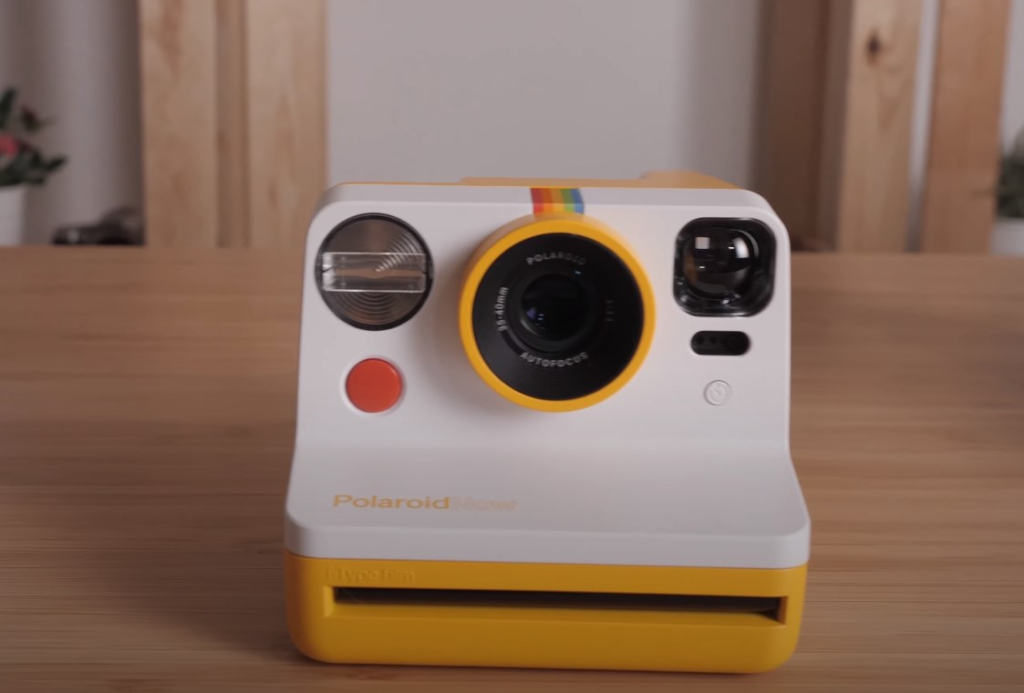
Positioned around the lens at the front, you’ll find the shutter and self-timer buttons along with the flash. The film emerges from below, and the viewfinder extends to the back, providing a comfortable user experience. On the rear, you’ll discover the flash, power buttons, and an LED film counter, completing the retro package.
In contrast, the 11 boasts a playful and curvy body, perfectly aligned with its youthful and contemporary vibes. Its design elements cater to the younger generation, evident from the bright colors and charming accessories.
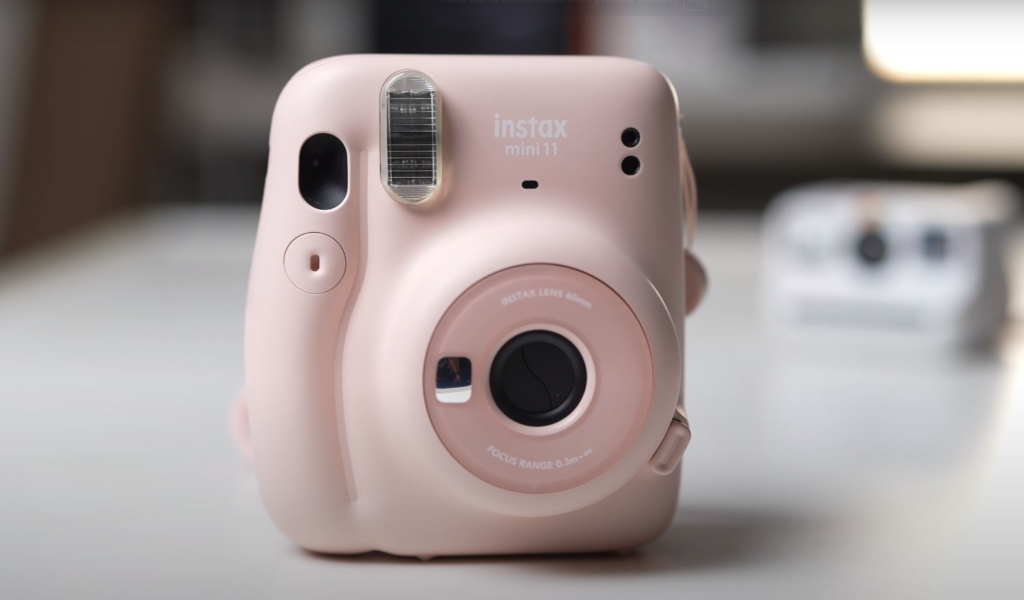
The camera’s appearance might even trick you into thinking it’s a toy, but a closer look reveals its expert lens and the developed film emerging from the top. Each package includes a hand strap and a rubber jewel button, enhancing the tactile experience of the smooth shutter button.
The key distinction between the two models lies in their target customer segments. The Polaroid Now appeals to loyalists of Polaroid Originals, radiating solid retro vibes that evoke nostalgia.
In its turn, the 11 aligns with modern aesthetics through its pastel colors and fancy accessories, capturing the hearts of teens and millennials seeking a youthful and trendy instant camera experience.
Design Comparison
Polaroid Now:
- Retro design with a boxy camera body and sharp edges;
- Streamlined appearance with fewer buttons;
- Shutter and self-timer buttons located around the lens at the front;
- Film emerges from below, while the viewfinder extends to the back;
- Flash, power buttons, and LED film counter positioned on the rear.
Instax Mini 11:
- Playful and curvy body design;
- Youthful and modern vibes with bright colors;
- Includes a hand strap and a rubber jewel button for a smoother shutter button experience;
- Developed film emerges from the top;
- Targets teens and millennials with its contemporary aesthetic and accessories.
Exploring the Specifications: Polaroid Now vs Instax Mini 11
Let’s examine the distinctive features and functionalities of these two cameras and get a deeper understanding of their photographic prowess.
From autofocus and lens switching to connectivity options and film compatibility, join us on this enlightening journey to uncover the specifications that set these cameras apart.
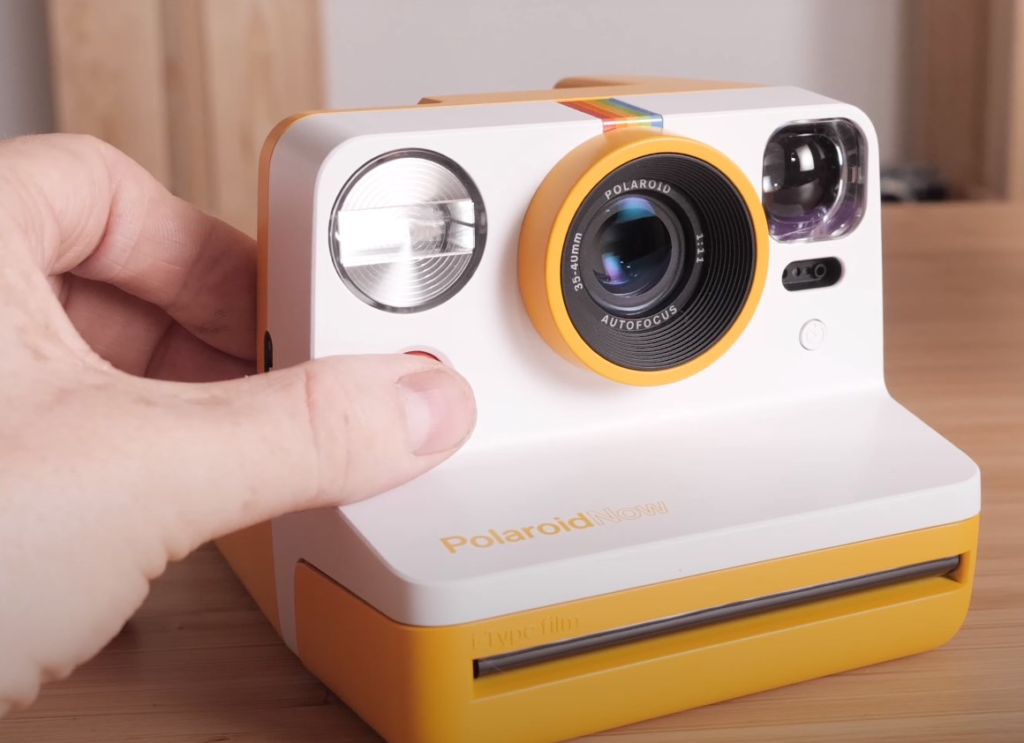
Polaroid Now:
- Autofocus feature that seamlessly switches between landscape and portrait modes;
- Object recognition enables automatic lens switching between the 35mm and 40mm options (with room for improvement in accuracy);
- No Bluetooth connectivity for selecting shots or modes using a phone;
- Selfie-timer available, but lacks a dedicated selfie mirror;
- Compatible with both classic 600 films and modern Polaroid i-Type films;
- Larger film size compared to the 11 and Instax Wide, offering more creative freedom for hanging or adding to a scrapbook;
- Cannot substitute Instax Mini film with Instax Wide film;
- Tripod socket included.
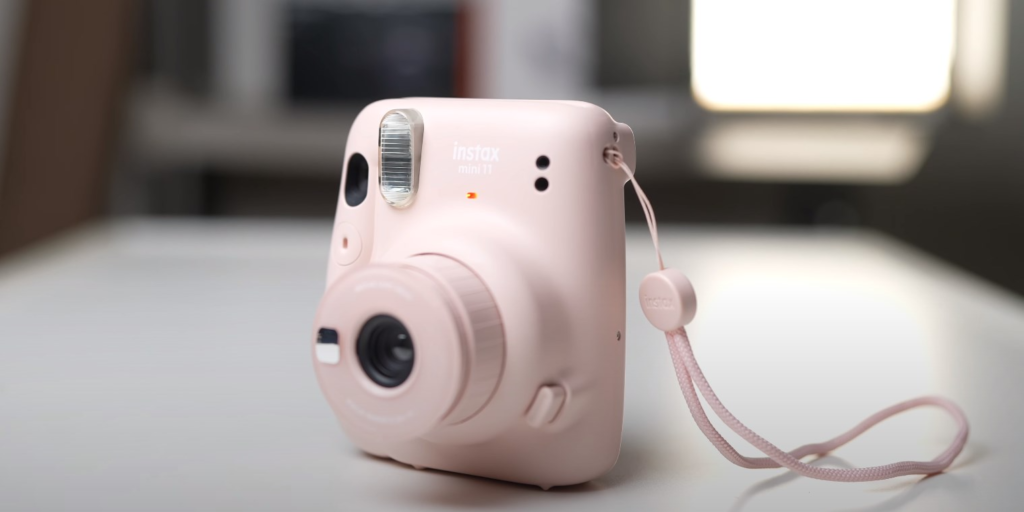
Instax Mini 11:
- Manual adjustment required for switching between landscape and portrait settings;
- Fixed lens without object recognition capabilities;
- No Bluetooth connectivity for remote control via phone;
- Selfie-timer functionality available, but lacks a dedicated selfie mirror;
- Exclusive compatibility with Instax Mini film;
- Smaller film size compared to Polaroid Now and Instax Wide, suitable for compact prints;
- Tripod socket not included, but can be positioned vertically on its flat bottom for stability.
All in all, the Polaroid Now offers the convenience of autofocus and versatile film compatibility, while the 11 prioritizes simplicity with its fixed lens and exclusive compatibility with Instax Mini film.
Powering Up: Battery and Charging Capabilities of Polaroid Now and Instax Mini 11
When it comes to battery and charging capabilities, the Now model offers the convenience of a built-in rechargeable battery, eliminating the need for frequent battery replacements. Simply connect the provided USB-A cable to the Micro-USB port to recharge the camera, ensuring a reliable power supply for numerous film packs.
In contrast, the Instax Mini 11 relies on two AA batteries, preferably Alkaline ones, to power its operations. It’s crucial to use the recommended battery type to avoid any potential issues with the camera’s LED indicator or functionality.
Check out the battery and charging specs of the two devices below:
Polaroid Now:
- Built-in rechargeable battery for convenient charging;
- Charging accomplished by connecting the provided USB-A cable to the camera’s Micro-USB port;
- A single recharge can sustain approximately 15 to 16 film packs;
- Ensures reliable power supply for extended usage.
Instax Mini 11:
- Relies on two AA batteries, similar to previous Instax models;
- Battery type: Alkaline batteries specifically recommended for Fujifilm Instax Mini cameras;
- A set of batteries typically lasts for around 10 film packs or approximately 100 shots;
- Using non-Alkaline batteries may result in LED indicator glitches or the camera failing to turn on;
- Easily replaceable batteries for uninterrupted shooting.
While the Polaroid Now prioritizes rechargeability, the Instax Mini 11 offers the flexibility of easily replaceable batteries, ensuring uninterrupted shooting by simply swapping out depleted batteries for fresh ones.
Capturing Moments: Comparing the Photographic Prowess of Polaroid Now and Instax Mini 11
When comparing the photo quality and performance, the Polaroid Now showcases notable improvements in its built-in flash, autofocus capabilities, and exposure controls. With its double exposure mode, it offers a creative edge for those seeking artistic expression.
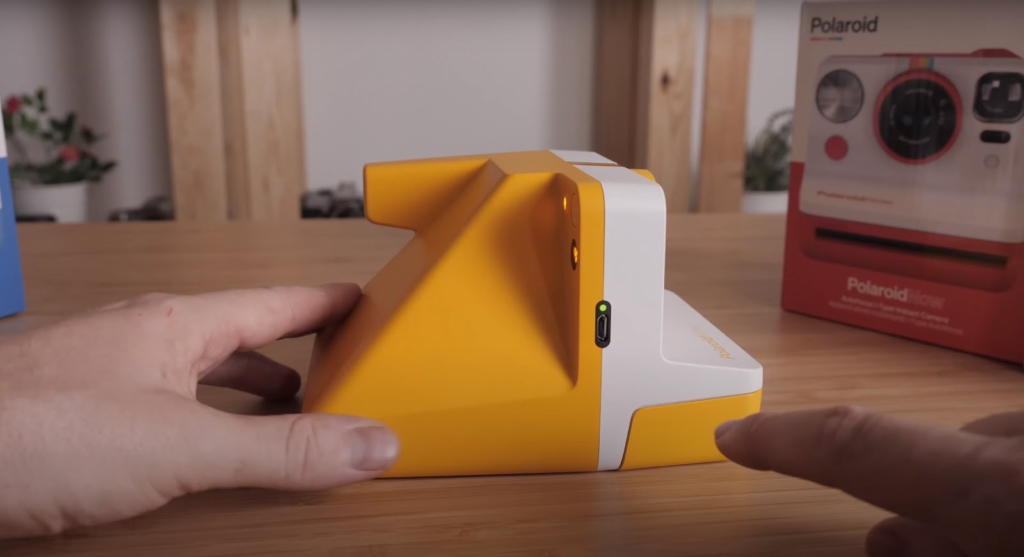
Polaroid Now:
- The upgraded built-in flash produces stronger and brighter lighting, ensuring accurate color reproduction and preventing overexposed photos;
- The Autofocus feature delivers decent photo quality suitable for beginners and enthusiasts, capturing moments with ease and clarity;
- Unique double exposure mode offers the opportunity for creative and dramatic shots, allowing users to express their artistic vision;
- Exposure controls provide better flexibility compared to other Instax cameras, granting greater control over the final image;
- Photo development time ranges from 10 to 15 minutes, unveiling captivating moments after a brief wait.
Interesting Fact: The Now’s design maintains a nostalgic touch while incorporating modern advancements, bridging the gap between vintage charm and contemporary functionality.
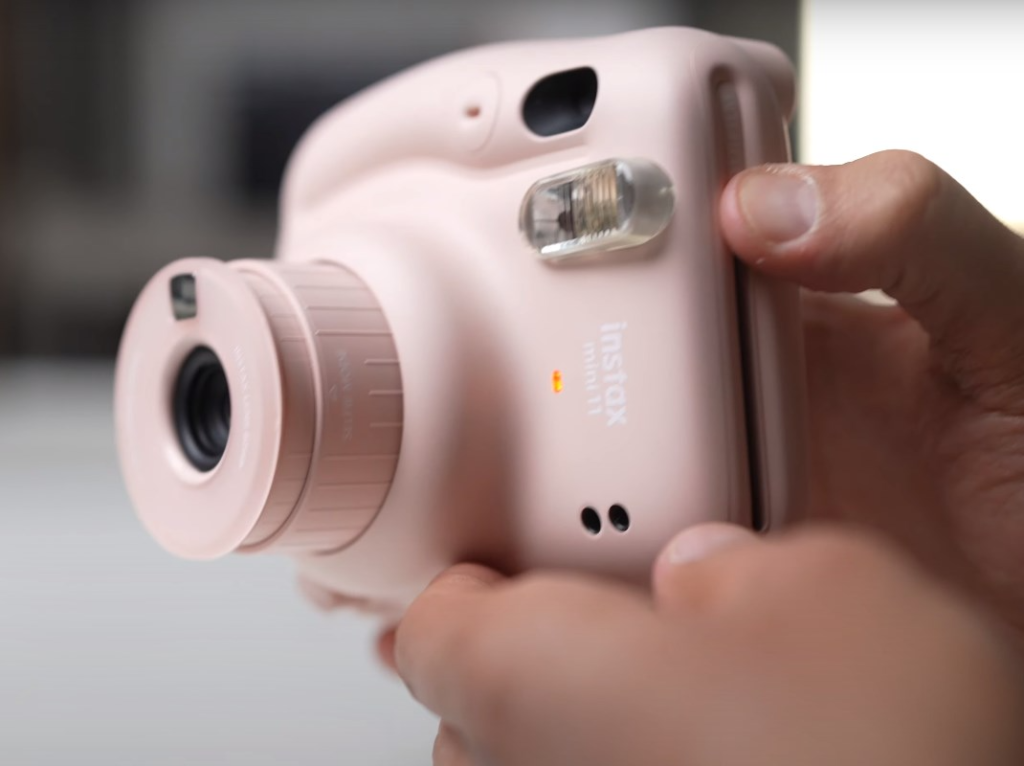
On the other hand, the 11 focuses on simplicity and accessibility, offering satisfactory photo quality and swift development time.
Instax Mini 11:
- The flash of the 11 tends to make images over-brighten, leaving room for improvement in terms of optimal lighting;
- Autofocus feature delivers satisfactory photo quality, ensuring clarity and capturing memorable moments for beginners and casual users;
- While lacking a double exposure feature, the 11 excels in simplicity and ease of use, making it accessible for all;
- Exposure control is fully automatic, limiting manual adjustment of brightness levels but simplifying the shooting experience;
- Photo development time is notably swift, typically within a couple of minutes, allowing for instant enjoyment of captured memories.
Interesting Fact: The Instax Mini 11’s compact and curvy design, coupled with its vibrant colors, reflects its target audience of teens and millennials, adding a touch of playfulness to the photographic experience.
Both cameras cater to different preferences, allowing users to capture and cherish their memories in unique ways. Check out the table below to see all the details about their quality and performance.
| Camera Model | Polaroid Now | Fujifilm Instax Mini 11 |
|---|---|---|
| Printing Method | Film | Film |
| Picture Size (without border) | 3.1” x 3.1” | 2.4” x 1.8” |
| Picture Size (with border) | 4.2” x 3.5” | 3.4” x 2.1” |
| Picture Format | 1:1 | 3:2 |
| Paper Capacity | 15 | 10 |
| Film Type | Polaroid Originals i-Type, Polaroid 600 | Instax Mini Instant Film |
| Film Developing Time | 10 to 15 minutes | 90 seconds |
| Flash | Yes | Yes |
| Deactivate Flash | Yes | No |
| Focal Length | 94.96 – 102.35mm | 60mm |
| Focus Type | Zone Focus | Fixed Focus |
| Minimum Focus Distance | 1.80′ / 55 cm | 11.81″ / 30 cm |
| Viewfinder Type | Optical | Optical |
| Exposure Mode | Automatic | Automatic |
| Selfie Mirror | No | Yes |
| Self-Timer | Yes | Yes |
| Battery and Charging | Micro-USB | 2 x AA batteries |
| Shots per Charge | Approximately 120 | Approximately 100 |
| Tripod Mount | No | No |
| Dimensions | 3.7″ x 4.4″ x 5.9″ | 4.24″ x 4.77″ x 2.65″ |
| Weight Without Film Pack | 0.95 lb | 0.65 lb |
| Warranty | Limited 1-Year Warranty | Limited 1-Year Warranty |
| Beginner-Friendly | Yes | Yes |
| Buy from Amazon | Polaroid Now Amazon link | Mini 11 Amazon link |
Additional Specifications:
- Polaroid Now allows users to deactivate the flash, providing more control over the lighting;
- Instax Mini 11 features a selfie mirror, making it convenient for self-portraits;
- The Now has a zone focus system, while Instax 11 has a fixed focus;
- The battery and charging method differ, with Polaroid Now using a Micro-USB and Fujifilm’s cam relying on 2 x AA batteries;
- Polaroid Now offers approximately 120 shots per charge, while Instax Mini 11 offers approximately 100 shots.
Please note that the Amazon links provided are examples and may not represent the actual links to purchase the cameras.
FAQ
Both the 11 and Now have their strengths, and the better choice depends on your specific needs. Polaroid Now offers higher performance and better photo quality on wide film, with improved focus. However, if you’re a beginner exploring instant photography, starting with the 11 is recommended. Instax Mini films are more affordable, and the exposure feature is better than that of the Fujifilm Instax Mini 90.
Instax and Polaroid are two distinct brands in the realm of instant photography. Instax is a branch created by Fujifilm, offering a range of instant cameras including models like Instax Mini 11, Mini 90, and previous iterations like Instax Mini 10. On the other hand, Polaroid is the original brand renowned for its cult cameras. The main difference lies in the brand history, with Polaroid representing retro and old-school aesthetics, while Instax embodies modernity and individuality.
Using an instant camera requires a different approach compared to digital photography. It may take some trial and error to become accustomed to shooting with an instant analog camera. Here are a few tips: provide ample lighting, as Polaroid cameras thrive in well-lit conditions; for the Mini, be cautious of overexposure in adequate light. Keep the camera steady when shooting and half-press the shutter button to focus before fully pressing it to capture the photo.
If your Instax Mini film is coming out blank, it’s likely due to exposure to light after loading it into the camera. Instant films are highly light-sensitive, so it’s crucial to store them away from light until use to ensure proper development.
To ensure proper film development, keep the film steady after taking the picture. Avoid shaking, squeezing, or creasing it during the development process, as this can disrupt the distribution of film chemicals. However, some photographers intentionally manipulate the film for creative effects during shooting.
If your film gets jammed during ejection, a low battery may be the culprit. Insufficient power can cause issues during the film ejection process. In such cases, try replacing or recharging the batteries while keeping the lens open to address the problem.
